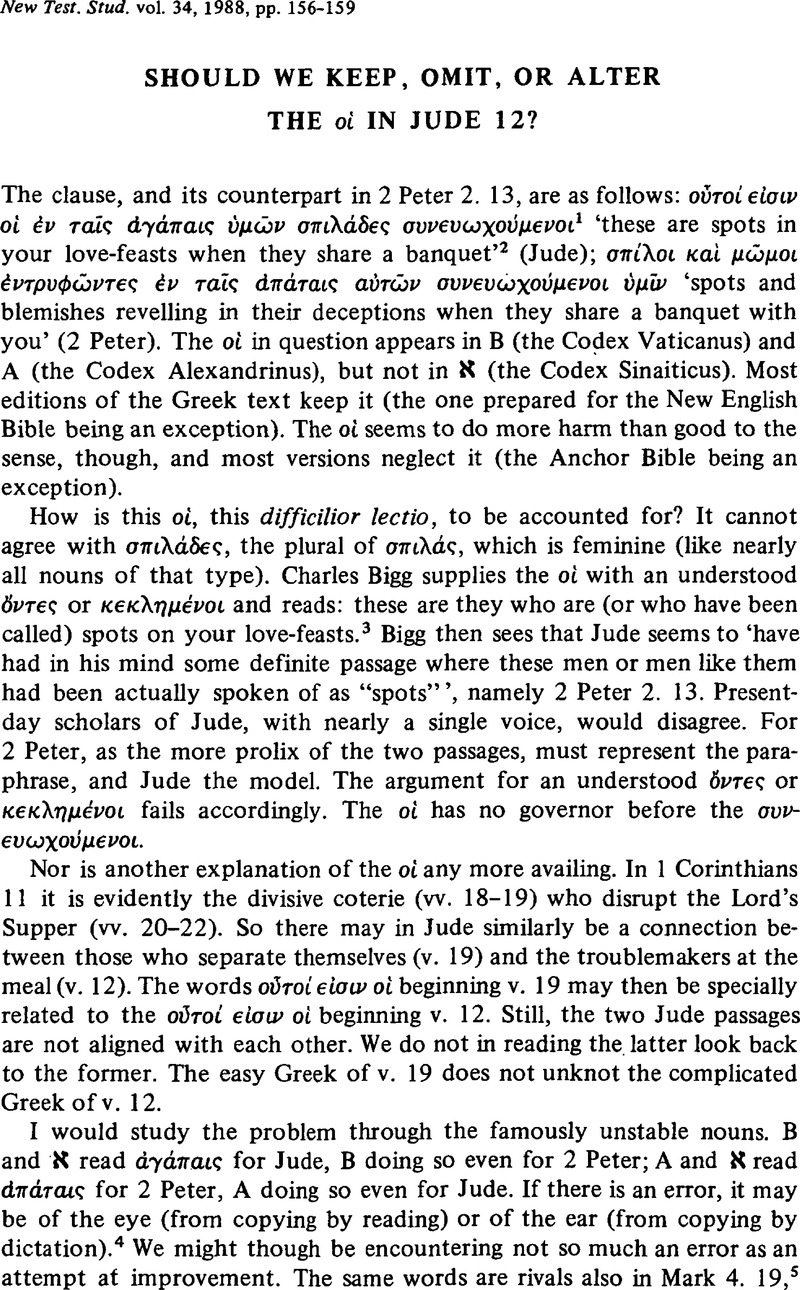No CrossRef data available.
Article contents
Should We Keep, Omit, or Alter the oi in Jude 12?
Published online by Cambridge University Press: 05 February 2009
Abstract

- Type
- Short Studies
- Information
- Copyright
- Copyright © Cambridge University Press 1988
References
NOTES
[1] So Westcott and Hort; and so Nestle and Kilpatrick, for the British and Foreign Bible Society. Some of the best authorities take the d άϕόβως following, in Jude, with the συνευωχούμενοι. A few authorities take the συνευωχούμενοι, in Jude though not in 2 Peter, to mean that the false shepherds gather among themselves at the communal meals.
[2] If there were a ὡς in the Greek, we should say ‘like’ or ‘as’ spots in your love-feasts; and such is the phrasing of Windisch, Hans, Handbuch zum neuen Testament: Die katholischen Briefe (Tübingen, 1911) 41:Google Scholar Diese sinds, die bei euren Agapen als Schandflecken mitschmausen.
[3] A Critical and Exegetical Commentary on the Epistles of St. Peter and St. Jude, ICC, 2nd ed. (Edinburgh, 1902) 333;Google Scholar cf. 282, 216–24 on the relation of Jude to 2 Albin, Peter. C. A., Judasbrevet (Stockholm, 1962) 666Google Scholar – agreeing that an ὂντς should be understood – refers to elements in vv. 1 (![]() πατρί ήγαπημένοις) and 21 (ἕλεος είς ζωήν αίωνιν) that he regards as likewise elliptical. I learned of Albin from Metzger, Bruce M., Manuscripts of the Greek Bible (New York, 1981) 118, and from Albin in turn I have taken the words cited below in n. 8.Google Scholar
πατρί ήγαπημένοις) and 21 (ἕλεος είς ζωήν αίωνιν) that he regards as likewise elliptical. I learned of Albin from Metzger, Bruce M., Manuscripts of the Greek Bible (New York, 1981) 118, and from Albin in turn I have taken the words cited below in n. 8.Google Scholar
[4] See in general Skeat, T. C., ‘The Use of Dictation in Ancient Book-Production’, Proceedings of the British Academy, 42 (1956) 179–208.Google Scholar
[5] Bauer, Walter, A Greek-English Lexicon of the New Testament and Other Early Christian Literature, trans. Arndt, William F. and Gingrich, F. Wilbur, 2nd ed. (Chicago, 1979) 82, s.v. άπάτη. Ecclesiastes 9. 6 is another instance of the one for the other.Google Scholar
[6] ‘άπατη as Love-Feast in the New Testament’, in Parola e Spirito: Studi in Onore di Settimio Cipriani (Brescia, 1982) vol. 1, 157–62.Google Scholar
[7] Word Biblical Commentary, vol. 50, Jude, 2 Peter (Waco, Texas, 1983) 266.Google Scholar
[8] Jew and Greek (London, 1953) 104.Google Scholar
[9] Following Liddell and Scott, Bigg cites the passage to illustrate σπιλάδες, but not to suggest άχάταις. Pliny, Natural History 37.5, similarly speaks of the maculae in the achates. The Shepherd of Hermas 9.26.2, cf. 9.6.4, 9.8.7, tells in a parable of σπίλοι in stones (not specifically άχ![]() ται); it is not the spots, but the stones, that represent faulty people, however; so there is no resemblance to Jude.
ται); it is not the spots, but the stones, that represent faulty people, however; so there is no resemblance to Jude.
[10] I offered (not without error) the ‘agates’ reading in my monograph Inconsistencies (Wood-bridge, Suffolk, 1983) 12. The argument of this paper is for the transposition of the diphthongs.Google Scholar




